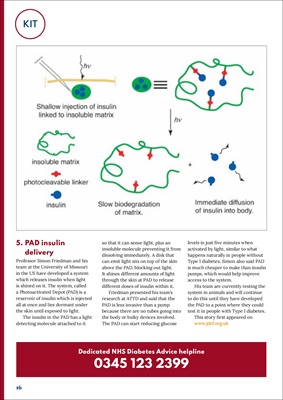
16KIT
5. PAD insulin
delivery
Professor Simon Friedman and his
team at the University of Missouri
in the US have developed a system
which releases insulin when light
is shined on it. The system, called
a Photoactivated Depot (PAD) is a
reservoir of insulin which is injected
all at once and lies dormant under
the skin until exposed to light.
The insulin in the PAD has a light
detecting molecule attached to it
so that it can sense light, plus an
insoluble molecule preventing it from
dissolving immediately. A disk that
can emit light sits on top of the skin
above the PAD, blocking out light.
It shines different amounts of light
through the skin at PAD to release
different doses of insulin within it.
Friedman presented his team's
research at ATTD and said that the
PAD is less invasive than a pump
because there are no tubes going into
the body or bulky devices involved.
The PAD can start reducing glucose
levels in just five minutes when
activated by light, similar to what
happens naturally in people without
Type 1 diabetes. Simon also said PAD
is much cheaper to make than insulin
pumps, which would help improve
access to the system.
His team are currently testing the
system in animals and will continue
to do this until they have developed
the PAD to a point where they could
test it in people with Type 1 diabetes.
This story first appeared on www.
jdrf.org.uk
Dedicated NHS Diabetes Advice helpline
0345 123 2399